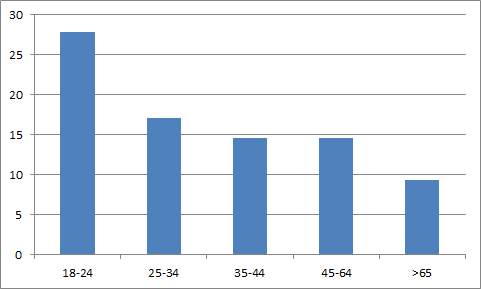Binge drinking continues to be a major cause of illness and death in the United States. Research strongly suggests that screenings and brief interventions can reduce alcohol consumption with lasting positive effects (e.g., Maciosek et al., 2009). The National Institute on Alcohol Abuse and Alcoholism (NIAAA) recommends that health professionals screen their patients for binge drinking and deliver brief interventions if they deem patients to be at risk. However, we know little about how frequently health professionals do this. In The DRAM this week, we review a nationwide survey that asked people if they had ever spoken to their doctors about alcohol use (McKnight-Eily et al., 2014).
Methods
- Researchers collected data from the most recent wave of the Behavioral Risk Factor Surveillance System (BRFSS), an annual nationwide telephone survey.
- A total of 166,753 U.S. adults at least 18 years old responded to the survey.
- In addition to questions about risk behaviors, the survey asked people whether a doctor or other health professional had ever talked with them about alcohol use. For those who answered affirmatively, the survey determined when the talk(s) occurred.
- The authors defined binge drinkers as people who reported consuming four or more drinks per occasion during the past 30 days for women, and five or more drinks for men.
- The authors defined heavy binge drinkers as people who reported 10 or more episodes of binge drinking during the past 30 days.
Results
- Of those who responded, only 16% reported ever discussing alcohol consumption with a health professional.
- Binge drinkers were more likely to report discussing alcohol use with health professionals (25%) but only a third of heavy binge drinkers had ever discussed alcohol use with a health professional.
- Young adults (18-24 years old) were more likely to report that their doctors asked them about alcohol use than older adults (see Figure).

Figure. Percentage of survey respondents who have ever spoken with professionals about alcohol use, by age group (adapted from McKnight-Eily et al., 2014). Click image to enlarge.
Limitations
- Self-report data are always subject to inaccuracy, especially when it depends on recalling past events.
- The survey collected information through landlines, which are increasingly underused as many people choose to use cell phones instead. In addition, the survey did not call participants living in institutional settings such as psychiatric hospitals and military bases. This might have generated an unrepresentative sample.
- The survey median response rate was just under 50%, which further raises the possibility of non-response bias.
- The survey did not ask whether a respondent had a health care provider at the time of the survey, in the past year or ever. This is a potential confound, because people would be less likely to report speaking to a doctor about alcohol use if they did not have a doctor.
Conclusions
These results indicate that screening rates for alcohol use are very low in the United States. Only 1 in 6 people reported that their doctors had ever asked them about their alcohol use. Younger adults and binge drinkers were more likely to report that they had spoken with a health provider about alcohol; however, the rates were still low. Doctors might shy away from asking their patients about alcohol use because they think that they do not have the resources to deal with the underlying issues. In reality, most patients who drink too much will only require brief counseling, not specialized treatment. Medical professionals should receive instruction in the addictions as part of their education so that they feel more comfortable having these conversations. Medical educators and health system administrators should focus on advocating for standardized brief screening procedures.
-Kat Belkin
What do you think? Please use the comment link below to provide feedback on this article.
References
Maciosek M.V., Coffield, A.B., Edwards, N.M., Flottemesch, T.J., Solberg, L.I. (2009) “Prioritizing clinical preventive services: a review and framework with implications for community preventive services.” Annual Review of Public Health, 341–55.
McKnight-Eily, L.R., Liu,Y., Brewer, R.D., Kanny, D., Lu, H., Denny, C.H., Balluz, L., Collins, J. (2014) “Vital signs: Communication between health professionals and their patients about alcohol use – 44 states and the District of Columbia, 2011.” CDC Morbidity and Mortality Weekly Report, 63(01), 16-22.




